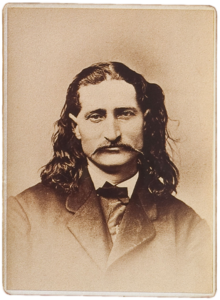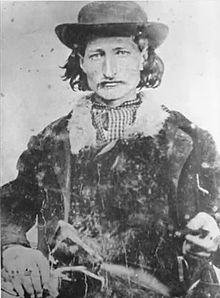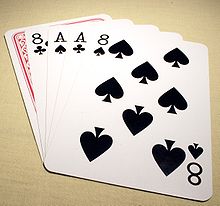| "Wild Bill" Hickok | |
|---|---|

James Butler "Wild Bill" Hickok, photograph date unknown
| |
| Born | James Butler Hickok May 27, 1837 Homer, LaSalle County, Illinois (present-day Troy Grove) |
| Died | August 2, 1876 (aged 39) Deadwood, Lawrence County, Dakota Territory (present-day Deadwood, South Dakota) |
| Cause of death | Murder by shooting |
| Resting place | Mount Moriah Cemetery, Deadwood, Dakota Territory |
| Other names | James B. Hickok, J.B. Hickok, Shanghai Bill, William Hickok, William Haycock |
| Occupation | farmer, vigilante, drover, teamster, wagon master, stagecoach driver, soldier, spy, scout, detective, lawman, gunfighter, gambler, showman, performer, actor |
| Parent(s) | William Alonzo Hickok and Polly Butler |
| Signature | |
James Butler Hickok (May 27, 1837 – August 2, 1876), better known as "Wild Bill" Hickok, was a folk hero of the American Old West, known for his work across the frontier as a drover, wagon master, soldier, spy, scout, lawman, gunfighter, gambler, showman, and actor. He earned a great deal of notoriety in his own time, much of it bolstered by the many outlandish - often fabricated - tales he told about his life. Some contemporary reports of his exploits are known to be fictitious but, along with his own stories, remain the basis for much of his fame and reputation.
Hickok was born and raised on a farm in northern Illinois, at a time when lawlessness and vigilante activity was rampant because of the influence of the "Banditti of the Prairie". Hickok was drawn to this ruffian lifestyle and headed west at age 18 as a fugitive from justice, working as a stagecoach driver and later as a lawman in the frontier territories of Kansas and Nebraska. He fought and spied for the Union Army during the American Civil War and gained publicity after the war as a scout, marksman, actor, and professional gambler. Over the course of his life, he was involved in several notable shootouts.
In 1876, Hickok was shot from behind and killed while playing poker in a saloon in Deadwood, Dakota Territory (present-day South Dakota), by Jack McCall, an unsuccessful gambler. The hand of cards which he supposedly held at the time of his death (including the ace of spades, the ace of clubs, the eight of spades and the eight of clubs) has become known as the dead man's hand.
Hickok remains a popular figure in frontier history. Many historic sites and monuments commemorate his life, and he has been depicted numerous times in literature, film, and television. He is chiefly portrayed as a protagonist, though historical accounts of his actions are often controversial.
Early life
James Butler Hickok was born May 27, 1837, in Homer, Illinois (present-day Troy Grove, Illinois) to William Alonzo Hickok, a farmer and abolitionist, and his wife Polly Butler.[1] His father was said to have used the family house, now demolished, as a station on the Underground Railroad. He was the fourth of six children. William Hickok died in 1852, when James was 15.[2] Hickok was a good shot from a young age and was recognized locally as an outstanding marksman with a pistol.[3] Photographs of Hickok appear to depict dark hair, but all contemporaneous descriptions affirm that it was red.[4]
In 1855, at age 18, James Hickok fled Illinois following a fight with Charles Hudson, during which both fell into a canal (each thought, mistakenly, that he had killed the other). Hickok moved to Leavenworth in the Kansas Territory, where he joined "General" Jim Lane's Free State Army (also known as the Jayhawkers), a vigilante group active in the new territory.[5] While a Jayhawker, he met 12-year-old William Cody (later known as Buffalo Bill), who despite his youth served as a scout just two years later for the U.S. Army during the Utah War.[6]
Nicknames
While in Nebraska, James Hickok was derisively referred to as "Duck Bill" for his long nose and protruding lips.[7][8] He grew a moustache following the McCanles incident and in 1861 began calling himself Wild Bill.[9][10] He was also known before 1861 by Jayhawkers as "Shanghai Bill" because of his height and slim build.[11]
James B. Hickok used the name William Hickok from 1858 and William Haycock during the Civil War. He was arrested while using the name Haycock in 1865. He afterward resumed using his given name, James Hickok. Most newspapers referred to him as William Haycock until 1869.
On March 5, 1876, Hickok married Agnes Thatcher Lake, a 50-year-old circus proprietor in Cheyenne, Wyoming Territory. Hickok left his new bride a few months later, joining Charlie Utter's wagon train to seek his fortune in the gold fields of South Dakota.[6] Martha Jane Cannary, known popularly as Calamity Jane, claimed in her autobiography that she was married to Hickok and had divorced him so he could be free to marry Agnes Lake, but no records have been found that support her account.[46] The two possibly met for the first time after Jane was released from the guardhouse in Fort Laramie and joined the wagon train in which Hickok was traveling. The wagon train arrived in Deadwood in July 1876.[47] Jane confirmed this account in an 1896 newspaper interview, although she claimed she had been hospitalized with illness rather than in the guardhouse.In 1876, Hickok was diagnosed by a doctor in Kansas City, Missouri, with glaucoma and ophthalmia.[citation needed] Though just 39, his marksmanship and health were apparently in decline, as he had been arrested several times for vagrancy,[45] despite earning a good income from gambling and displays of showmanship only a few years earlier.
Shortly before Hickok's death, he wrote a letter to his new wife, which read in part, "Agnes Darling, if such should be we never meet again, while firing my last shot, I will gently breathe the name of my wife—Agnes—and with wishes even for my enemies I will make the plunge and try to swim to the other shore."[48]
Death
On August 1, 1876, Hickok was playing poker at Nuttal & Mann's Saloon in Deadwood, Dakota Territory. When a seat opened up at the table, a drunk man named Jack McCall sat down to play. McCall lost heavily. Hickok encouraged McCall to quit the game until he could cover his losses and offered to give him money for breakfast. Though McCall accepted the money, he was apparently insulted.[49] The next day, Hickok was playing poker again. He usually sat with his back to a wall so he could see the entrance, but the only seat available when he joined the game was a chair facing away from the door. He asked another man at the table, Charles Rich, to change seats with him twice, but Rich refused.[50]
McCall entered the saloon, walked up behind Hickok, drew his Colt's Model 1873 Single Action Army .45 calber revolver and shouted, "Damn you! Take that!" He shot Hickok in the back of the head at point-blank range.[51] Hickok died instantly. The bullet emerged through Hickok's right cheek and struck another player, riverboat Captain William Massie, in the left wrist.[52][53] Hickok may have told his friend Charlie Utter and others who were traveling with them that he thought he would be killed while in Deadwood.[54]
Jack McCall's two trials
McCall's motive for killing Hickok is the subject of speculation, largely concerning McCall's anger at Hickok giving him money for breakfast the day before, after McCall had lost heavily.[55][56]
McCall was summoned before an informal "miners jury" (an ad hoc local group of miners and businessmen). McCall claimed he was avenging Hickok's earlier slaying of his brother, which may have been true. A man named Lew McCall was killed by an unknown lawman in Abilene, Kansas, but it is not known if the two men were related.[56] McCall was acquitted of the murder. The acquittal prompted editorializing in the Black Hills Pioneer: "Should it ever be our misfortune to kill a man ... we would simply ask that our trial may take place in some of the mining camps of these hills." Calamity Jane was reputed to have led a mob that threatened McCall with lynching, but at the time of Hickok’s death, Jane was being held by military authorities.[57]
After bragging about killing Hickok, McCall was re-arrested. The second trial was not considered double jeopardy because of the irregular jury in the first trial and because Deadwood was in Indian country. The new trial was held in Yankton, the capital of the Dakota Territory. Hickok's brother, Lorenzo Butler, traveled from Illinois to attend the retrial. McCall was found guilty and sentenced to death. Leander Richardson, a reporter, interviewed McCall shortly before his execution and wrote an article about him for the April 1877 issue of Scribner's Monthly. Butler spoke with McCall after the trial and said he showed no remorse.[58]
Jack McCall was hanged on March 1, 1877, and buried in a Roman Catholic cemetery. The cemetery was moved in 1881, and when his body was exhumed, the noose was found still around his neck.[59]
Dead man's hand
Hickok was playing five-card draw when he was shot. He was holding two pairs, black aces and black eights. The fifth card had been discarded, and its replacement had possibly not been dealt. The identity of the fifth card is the subject of debate.[notes 8]
Burial
Charlie Utter, Hickok's friend and companion, claimed Hickok's body and placed a notice in the local newspaper, the Black Hills Pioneer, which read:
Almost the entire town attended the funeral, and Utter had Hickok buried with a wooden grave marker reading:
Hickok is known to have fatally shot six men and is suspected of having killed a seventh (McCanles). Despite his reputation,[60] Hickok was buried in the Ingelside Cemetery, Deadwood's original graveyard. This cemetery filled quickly, and in 1879, on the third anniversary of his original burial, Utter paid to move Hickok's remains to the new Mount Moriah Cemetery.[notes 9] Utter supervised the move and noted that, while perfectly preserved, Hickok had been imperfectly embalmed. As a result, calcium carbonate from the surrounding soil had replaced the flesh, leading to petrifaction. One of the workers, Joseph McLintock, wrote a detailed description of the re-interment. McLintock used a cane to tap the body, face, and head, finding no soft tissue anywhere. He noted that the sound was similar to tapping a brick wall, and believed the remains to weigh more than 400 lb (180 kg). William Austin, the cemetery caretaker, estimated 500 lb (230 kg), which made it difficult for the men to carry the remains to the new site. The original wooden grave marker was moved to the new site, but by 1891 it had been destroyed by souvenir hunters whittling pieces from it, and it was replaced with a statue. This, in turn, was destroyed by souvenir hunters and replaced in 1902 by a life-sized sandstone sculpture of Hickok. This, too, was badly defaced, and was then enclosed in a cage for protection. The enclosure was cut open by souvenir hunters in the 1950s, and the statue was removed.[61]
Hickok is currently interred in a ten-foot (3 m) square plot at the Mount Moriah Cemetery, surrounded by a cast-iron fence, with a U.S. flag flying nearby.[62] A monument has been built there. It has been reported that Calamity Jane was buried next to him, according to her dying wish. Four of the men on the self-appointed committee who planned Calamity's funeral (Albert Malter, Frank Ankeney, Jim Carson, and Anson Higby) later stated that, since Hickok had "absolutely no use" for Jane in this life, they decided to play a posthumous joke on him by laying her to rest by his side.[63] Potato Creek Johnny, a local Deadwood celebrity from the late 19th and early 20th centuries, is also buried next to Wild Bill.[64]
Pistols known to have been carried by Hickok
Hickok's favorite guns were a pair of Colt 1851 Navy Model (.36 caliber) cap-and-ball revolvers. They had ivory grips and silver plating and were ornately engraved with "J.B. Hickok–1869" on the backstrap.[65] He wore his revolvers butt-forward in a belt or sash (when wearing city clothes or buckskins, respectively), and seldom used holsters per se; he drew the pistols using a "reverse", "twist" or cavalry draw, as would a cavalryman.[6]
At the time of his death Hickok was wearing a Smith & Wesson Model 2 Army Revolver, a newly released five-shot, single-action 38 cal. weapon. Bonhams auction company offered this pistol at auction on November 18, 2013, in San Francisco, California,[66] described as Hickok's Smith & Wesson No. 2, serial number 29963, a .32 rimfire with a six-inch barrel, blued finish and varnished rosewood grips. The gun did not sell because the highest bid of $220,000 was less than the reserve set by the gun's owners.[67]







No comments:
Post a Comment